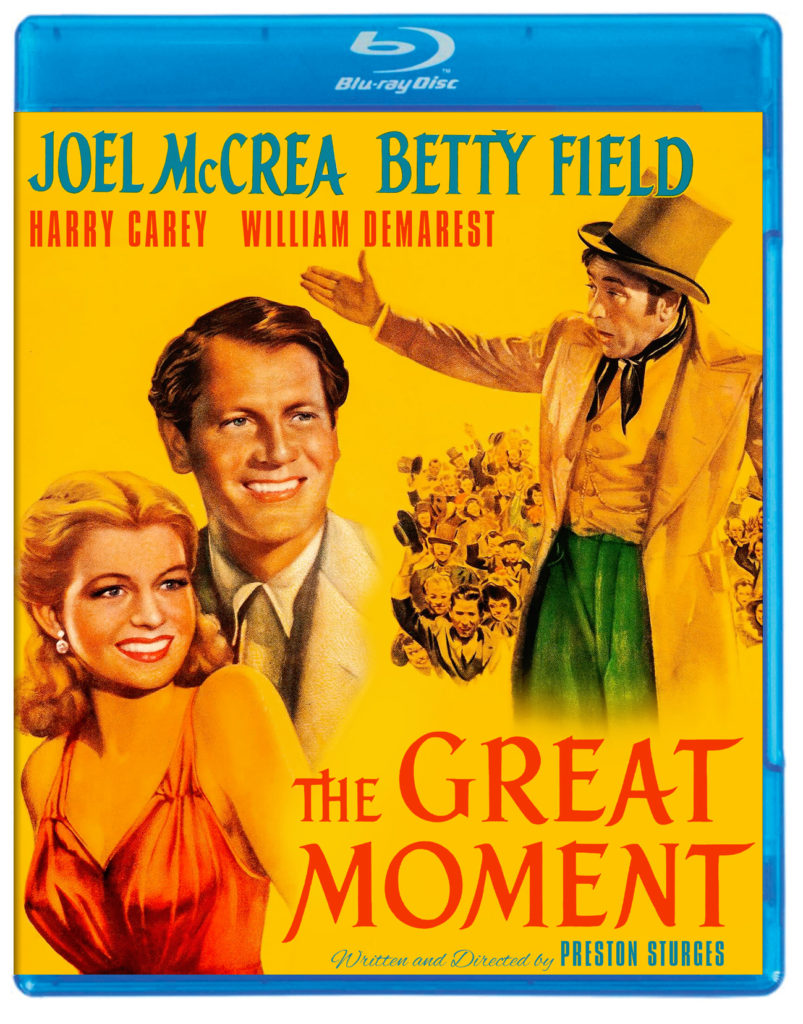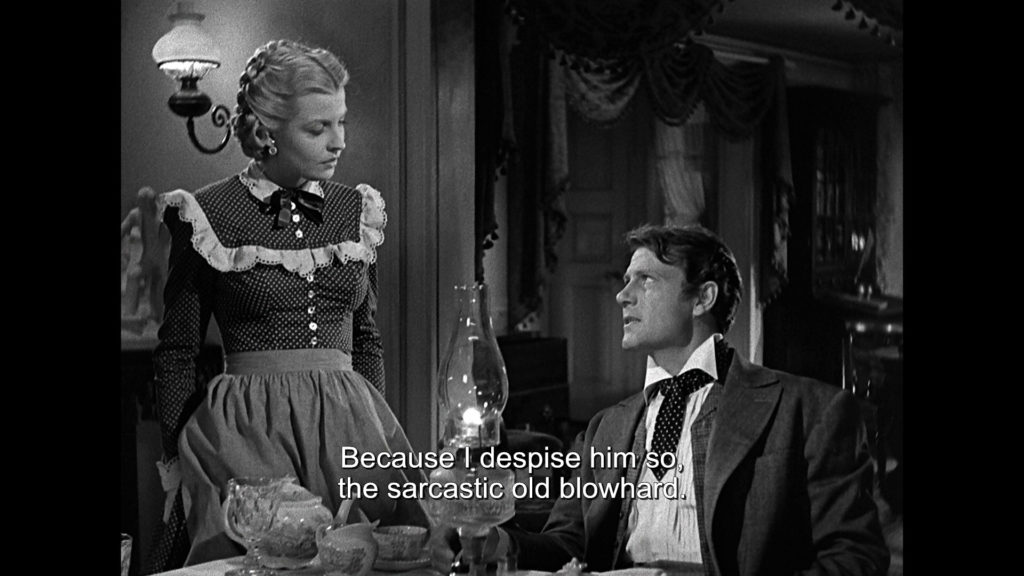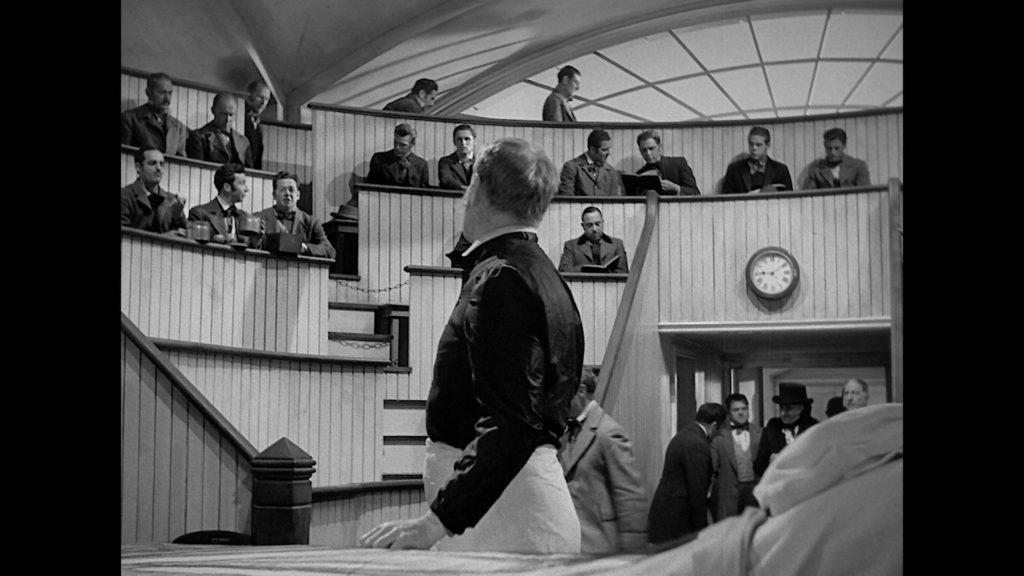Triumph Over Memory

DIRECTED BY PRESTON STURGES/1944
STREET DATE: FEBRUARY 8TH, 2022/KINO LORBER STUDIO CLASSICS
Preston Sturges’ 1944 biographical drama of medical discovery The Great Moment – made during the writer-director’s incredible run of comedies at Paramount Studios during the first half of the 1940s – comes to Blu-ray this February with key introductory discussions and informed contextualization from film historian Constantine Nasr, the late filmmaker Peter Bogdanovich, and Preston Sturges’ youngest son Tom Sturges.
The real-life tragedy of what was eventually released in September of 1944 as The Great Moment, mirroring the screen biographical tragedy of mid-nineteenth century dentist W.T.G. Morton, bookends Preston Sturges’ career as writer-director at Paramount Studios. Shot in mid-1942, during a peerless reputation of unmatched comedy brilliance established by, in succession, The Great McGinty (1940), Christmas in July (ibid.), The Lady Eve (’41), Sullivan’s Travels (ibid.), and The Palm Beach Story (’42), and immediately followed by a pair of equally brilliant, some might say definitive, satires on smalltown Middle American life during wartime, the still trenchant and gaspingly hilarious The Miracle of Morgan’s Creek (1944) and Hail, the Conquering Hero! (ibid.), The Great Moment – for its grandiose title – ironically appeared in theaters long after Sturges’ employment with the studio had ended. In an odd twist also reminiscent of Sturges’ original conception for the film, especially regarding its scene-fracturing dramatic structure, Sturges’ involvement with the long-gestating project actually predates all his directed comedy masterpieces, when he was first tasked as Paramount’s top screenwriter, with unimpeachable credits such as The Good Fairy (1935), Easy Living (’37), and If I Were King (’38) already to his name, to screen-adapt a seemingly unadaptable doorstopper, a studio property written by one René Fülöp-Miller, which purported to relate the mid-nineteenth century medical-historical discovery of anesthesia.
Singularly unpromising as a dramatic subject, Sturges nevertheless broke with a story-template already established by the sometimes-stultifying multiple Oscar-winner The Story of Louis Pasteur (1936), and reappearing later in such still-drier fare as Dr. Ehrlich’s Magic Bullet (’40) and Madame Curie (’43), by instead focusing attention in a comparatively unusual way on a minor figure from the periphery of that larger story whose discovery, sacrifice, and subsequent downfall was as meteoric as, in the context of history, it was potentially overlooked. In the sad, disappointed life of W.T.G. Morton – an otherwise unremarkable dentist who nevertheless pioneered the use of ether as an anesthetic, and who later refused to profit off his discovery – Sturges’ saw an opportunity to revisit a style of screenplay construction he had, years earlier, termed “narratage”.
Sturges first used this time-jumping storytelling style for his Hollywood breakthrough as screenwriter, in the 1933 Fox film The Power and the Glory, where Spencer Tracy, early in his career, starred as a deceased early twentieth century tycoon about whom other characters film-length reminisce in overlapping, sometimes conflicting, flashbacks. In terms of the main character’s triumphs, flaws, mistakes, and ultimate tragedy, over an eventful, controversial life, this became in retrospect a style of film-biographical storytelling that anticipated its much more celebrated and well-known usage seven movie-years later with Orson Welles’ Citizen Kane (1941). But even before that later film premiered, with the inherently ironic although keenly inspiring story of Dr. Morton, Sturges hoped to mix comedy and drama, slapstick and tragedy, in a similarly and unusually resonant story-construction, connected to an unmoored temporal framework, which would dramatize life as lived in the actual experience of living it: in memory, in joy, and in regret.
These lofty ambitions, however, had virtually vanished in what finally appeared, after a storied and much sorrier journey to the screen, as The Great Moment. Production delay, clashing egos, and studio interference – including re-writing, re-editing, and re-shooting – had by that point transformed Preston Sturges’ once promising project of Triumph Over Pain – the director’s preferred title – through descending and less-promising iterations as Morton the Magnificent and Great Without Glory, to its ultimate compromise as The Great Moment.
Which, one regrets to say, is what audiences saw in September of 1944 long after Sturges might have had anything to do about it – having expended all his energy and influence by that point saving both Miracle of Morgan’s Creek and Hail the Conquering Hero! from a similar fate during the three later films’ war-related release delay… and which, most recently, Kino Lorber dutifully presents on Blu-ray, as we in the book business put it, “as-is”.
…

As-Is, then, The Great Moment’s many defects of construction, continuity, stylistic consistency, and tonal incongruity – to say nothing of Letheon-like lapses and leaps in logic and lucidity – are readily and fatally apparent from the film’s opening passage: which contains no less than four unmotivated flashbacks, three false beginnings, and a credits background-sequence which may or may not be happening in the film’s subsequently established reality. Regarding the latter, a triumphant parade with marching bands, streamers and congratulate throngs wielding signs proclaiming “Triumph Over Pain”? Nothing in the evidence of the storyline that (eventually) unfolds would suggest that Dr. Morton was ever widely recognized, much less celebrated, for his discoveries – seemingly beset at all points by slander, mistrust, misunderstanding, jealousy, and calumny from peers and patients alike – so this wishful procession may very well represent a more incisive Triumph Over Memory.
Not that the existing edit of The Great Moment suggests such a reading/viewing, but what does become apparent – despite the slapdash and continuing awkwardness of its initial presentation – is how effectively nonetheless the vivid personalities on-screen carry us through subsequent confusion, and who in fact manage to maintain our interest throughout. This screen procession of welcome faces and personalities, scattered throughout their otherwise indifferent presentation, include: spindly Jimmy Conlin keeping a brisk shop and sententious Thurston Hall making ponderous speeches; timid Byron Foulger quietly shuffling papers and no-nonsense Al Bridge serving them; hatchet-faced ex-boxer Frank Moran holding a patient down on an operating bed and fluttery ex-showgirl Esther Howard being nearly asphyxiated by nitrous oxide; fringe-bearded Julius Tannen (representing ‘the medical establishment’) bellowing sarcastic remarks and pencil-mustachioed Franklin Pangborn (embodying ‘proper medical procedure’) hissing fussy ones; and finally the great William Demarest as the beautifully named Eben Frost, who enters Dr. Morton’s life with a toothache and a violin case and becomes his most hilariously devoted guinea pig. No, even the Unofficial Preston Sturges Stock Company can’t save The Great Moment – including many others I didn’t mention above – but they come damn near close.
Obviously what otherwise couldn’t be touched by interfering hands and cutting shears, then, is the individual scenes and the overall strength of the writing. Particularly modern and effective is how The Great Moment deflates what would otherwise by clichéd scenes of Great Discovery to the terms of everyday life and general understanding. What motivates Dr. Morton is not the lofty muse of scientific methodology but rather the prosaic pragmatism of his dental profession. He simply wants to do his job without inflicting needless pain on his patients, and so in mishearing chloric ether as sulfuric ether, negligently falling asleep next to a fire as the dangerous inhalant vaporizes the surrounding air, and eventually impaling his hand through a letter-stopper, these “moments” all become realistic and offbeat part of the – mainly accidental – nature of Dr. Morton’s “discoveries”.
Joel McCrea – who surely did his best screenwork in Sturges’ Sullivan’s Travels, and whose bemused yet heroically persistent romantic figure was key to the considerable comic success of The Palm Beach Story – plays Morton with the underconfident humility which at times seem a bit put-on with a Gary Cooper, James Stewart, or even a Henry Fonda, but with McCrea somehow felt (and feels) never less than real. Possibly this was a quality Sturges alone recognized in McCrea – an actor who would eventually go back to his greater comfort-zone of Westerns following his three-film association with Sturges – and his slightly embarrassed smile and uninflected, accent-less line-readings, along with the actor’s equal reserves of steel-eyed temper and ramrod moral resolve, also (very) nearly impart sense and resonance to his character’s life-journey where the film and its (lack of) structure most fail him (and us).
…

One has tried to point out the strengths and deficiencies of The Great Moment As-Is, but for those who wish to know more about the complications of circumstances that resulted in a butchered classic – or at least a film production that may have been radically different than what ended up on the screen – Kino Lorber has recruited film historian Constantine Nasr, who provides an eighteen-minute introduction to the film, and a Covid-era Zoom discussion between Nasr, the late Peter Bogdanovich, and Tom Sturges. Bogdanovich in particular no stranger to the film maudit – one recalls having seen at least three of his films, At Long Last Love (1975), Nickolodeon (’76), and They All Laughed (’81), in at least two different versions each (even the standard home video version of his most well-known film, The Last Picture Show (’71) is not the version audiences originally saw in theaters) – so it is undoubtedly extremely appropriate that the beleaguered late director’s possibly final appearance on a home video special feature should be in discussing a famously compromised film product of major studio interference.
Nasr and Tom Sturges are equally insightful, and their background/backlot story of Preston Sturges losing control of what was eventually released as The Great Moment stemming from an apparently long-standing rivalry between Sturges and Paramount producer Buddy DeSylva – the latter balking from Sturges apparently having refused to cast Betty Hutton in the starring role of The Lady Eve, which Sturges had specifically written for Barbara Stanwyck (Sturges would go on to cast Hutton in The Miracle of Morgan’s Creek, however) – has just about the right ring of real-life absurdity to it to seem Gospel Truth.
In closing, one line from The Great Moment has stuck with me the many times I have returned to it, where the monumental Harry Carey’s conscience-stricken surgeon Dr. Warren assures a patient before operating – in those dark times before anesthetic – that “pain carries no memory”. I don’t know if this is in fact true – does pain in its many guises emotional, physical, and otherwise, carry no sense-memory? – but it does make me wonder in relation to the film that Is whether the film that Might Have Been could have provided an answer to that question, or at least addressed that question in a more interesting way. Possibly imagining the scenes of our now purely imaginary Triumph Over Pain falling in their more dramatically effective order — with the strong performances balancing the emotional content of the writing — and time itself a comic-tragic character — carrying Dr. Morton, “the eradicator of pain”, through experiences joyful and sad, proud and shameful, nostalgic and longing, and, yes, pleasant and painful — might have themselves triumphed over the unforgiving cul-de-sac of memory.
Images used in this review are credited to DVDBeaver.

